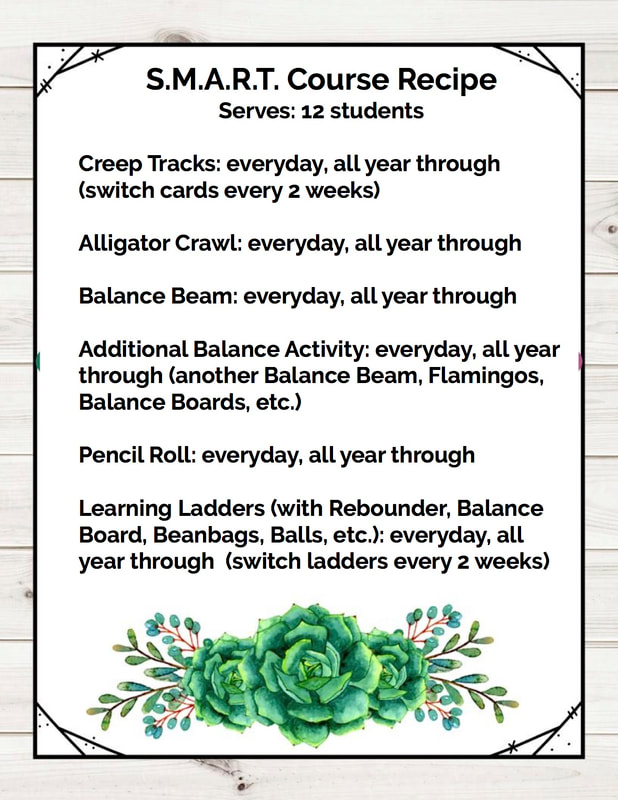|
Your child came home and started talking about doing S.M.A.R.T. at school, but what does that mean? S.M.A.R.T. stands for Stimulating Maturity through Accelerated Readiness Training, it’s a developmental movement program that helps to get children’s brains and bodies ready to learn and uses movement to anchor learning. Here is how that looks in a classroom:
0 Comments
S.M.A.R.T. Teachers everywhere set up their courses to maximize the important brain stimulation their students need. After many years of supporting and guiding teachers and schools with their S.M.A.R.T. programs we have come up with a S.M.A.R.T. course recipe we hope you will adopt and use! As you can see in our recipe we want your students to creep, crawl, and roll every day. Also we want them to do balance beams and additional balance activities, as well as the Overhead Ladder and Learning Ladders each day. Having TWO spots for creeping and TWO spots for crawling in your S.M.A.R.T. course will increase the frequency, intensity, and duration of the important stimulation these activities provide. Remember, MANY of your students missed these stages AND, with repeating the activity, you don't have to TEACH so many stations!
Download: September Newslette S.M.A.R.T. Recipe (PDF) References: S.M.A.R.T. Pre-K CORE Guide pages 33-34 (Pencil Rolls); pages 40-41 (Balance Beam); pages 47-49 (Alligator Crawl); pages 50-53 (Slap Track) S.M.A.R.T. Curriculum Guide pages 36-37 (Pencil Rolls); pages 51-53 (Balance Beam); pages 66-68 (Alligator Crawl); pages 69-71 (Creep Track) It’s the beginning of the year so that means you barely have time to eat lunch let alone make new cards for your Slap/Creep Track! We’re here to support you during this busy time and are giving you a set of handprint cards to download and print. Use colored paper when printing for a quick and easy start to the year. The handprints allow your students to focus on looking at each card before gently slapping it with a “high five”. Remember the goal is smooth fluid movement through the Slap/Creep Track and these cards are a great way to achieve it. Psst! Save the download to your S.M.A.R.T. Program folder.
Download: Slap/Creep Track Hands Cards (PDF) References: S.M.A.R.T. Pre-K CORE Guide pages 50-53 S.M.A.R.T. Curriculum Guide pages 69-71 Here is what you should teach this the first day of S.M.A.R.T., regardless of the type of S.M.A.R.T. Space (classroom, S.M.A.R.T. Room, PE, or Hallway) you have. Day 1: Introduce the Alligator Crawl and Balance Beam. With the Alligator Crawl, emphasize saying low, reaching out to touch the midline and using opposite arm and leg. You can demonstrate how to do the Alligator Crawl or have a child model. Then let all the students practice 2-3 times. For the Balance Beam, emphasize the slow, heel-toe walk. In the beginning, make a mark on the tapeline or beam to identify when the next person can start. As with the Alligator Crawl, let each student try it 2-3 times. Day 2: Review Alligator Crawl and Balance Beam by letting each child try it 1-2 times. Day 3: Introduce Slap/Creep Track and the Pencil Roll. With the Creep Track, teach slow steady creeping while looking at each card. For the Pencil Roll, focus on using the hips to rotate the body and keeping arms and legs straight. Model each activity or have a child demonstrate, then let the students try it.
References:
S.M.A.R.T. Pre-K CORE Guide pages 33-34 (Pencil Rolls); pages 40-41 (Balance Beam); pages 47-49 (Alligator Crawl); pages 50-53 (Slap Track) S.M.A.R.T. Curriculum Guide pages 36-37 (Pencil Rolls); pages 51-53 (Balance Beam); pages 66-68 (Alligator Crawl); pages 69-71 (Creep Track) |
AuthorSCheryl Smythe Archives
May 2024
|





 RSS Feed
RSS Feed